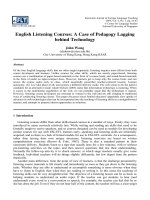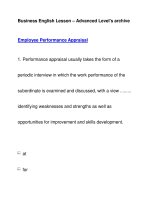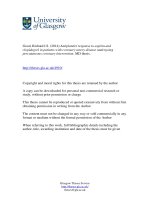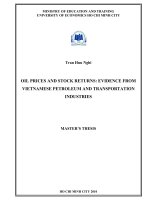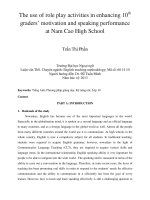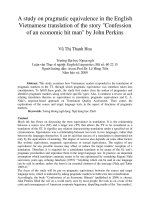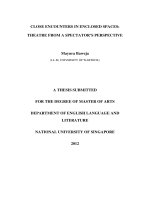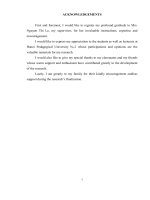Errors in English business emails written by Vietnamese people working in foreign companies
Bạn đang xem bản rút gọn của tài liệu. Xem và tải ngay bản đầy đủ của tài liệu tại đây (727.47 KB, 57 trang )
THUONGMAI UNIVERSITY
ENGLISH FACULTY
------
GRADUATION PAPER
TOPIC:
ERRORS IN ENGLISH BUSINESS EMAILS WRITTEN BY
VIETNAMESE PEOPLE WORKING IN FOREIGN
COMPANIES
Supervisor:
Student:
Ms. Pham Thi Phuong
Nguyen Thi Luu Yen
Class: K53N5
Student Code: 17D170283
HANOI - 2020
ABSTRACT
Business correspondence is a term people often meet in the business field. In any
type of business correspondence, writing business emails have always been the most
common way of communicating between businessmen because it can save time and
travel costs by exchanging work via emails and social networks. Obviously, business
email writing skills are becoming increasingly essential in the field of business,
especially in companies cooperating with foreign countries. However, not everyone
can write it perfectly. In fact, writing is considered one of the most challenging skills
among the four language skills, it always requires meticulousness and elaborateness.
Specifically, writing English business email seems to be more difficult because it
requires a skillful combination of specialized knowledge as well as an extensive
knowledge of English. In reality, when writing English business emails, the writer can
meet several problems relate to lexis, grammar, meaning expression, styles, and
formats, etc. There have been a number of studies in the field of business
correspondence, but there are still gaps in the topic of common errors in English
business emails. As a result, this study was conducted to fill those gaps. This research
is aimed at Vietnamese people working in foreign companies, focusing on studying
their errors when dealing with business emails, then find out the possible solutions for
both the staff and the company. Besides, the study also targets at making some
suggestions as a useful reference to help businessmen avoid mistakes that should not
have occurred in writing English business email. To achieve those aims, the researcher
applied a quantitative method to conduct the research. The author also used the
technique of analyzing to delve deeper into the issue. The gathered data includes fifty
real emails written by staff working in foreign companies and presented as a
percentage to make a comparison. The findings from this research are hoping to be
useful not only for the Vietnamese people working in foreign companies but also for
all employees in general.
1
ACKNOWLEDGEMENTS
During the process of doing this graduation paper, I have received much
necessary assistance as well as precious ideas from my teachers, family, and friends.
Their kindly help, care, encouragement gave me strength and lift me to complete this
graduate paper.
First and foremost, I would like to express my profound respect and heartfelt
gratitude to my supervisor Ms. Pham Thi Phuong for her whole-hearted assistance,
thoughtful advice, comments as well as valuable time from the preparation to the
completion of this research. Her support was very precious for me to improve my
understanding of this subject. Without her motivation and instructions, the study would
have never been done effectively.
Secondly, my sincere thanks also go to all the teachers at the English Faculty of
Thuongmai University for their enthusiasm in teaching me useful lessons, bringing
valuable knowledge, and providing us with a good environment to fulfill this
graduation paper.
Besides, this research could not be completed without the enthusiastic
cooperation of the staff in Bamboo Software Co. Ltd. They enthusiastically
cooperated, supported, and provided me documents needed for the research. So, I also
would like to present my deepest gratefulness to all of them for providing useful.
Furthermore, I would like to express my sincere gratitude to all authors of
textbooks and documents listed in the reference part. The ideas and results in these
reference materials have been reflected and developed in this study.
Last but not least, I owe sincere and earnest thankfulness to my parents for their
endless love, and have the most assistance as well as motivation for me. I also would
love to express my thanks to my brothers and friends for encouraging and enthusiastic
support me a lot as well as giving me much useful advice for me in finishing my
graduation paper.”
Hanoi, November 23rd, 2020
Student
Nguyen Thi Luu Yen
2
TABLES OF CONTENTS
ABSTRACT............................................................................................................................................i
ACKNOWLEDGEMENTS............................................................................................................ii
TABLES OF CONTENTS..............................................................................................................iii
LIST OF ABBREVIATIONS..........................................................................................................v
LIST OF TABLES AND FIGURES............................................................................................vi
CHAPTER 1: OVERVIEW OF THE STUDY........................................................................1
1.1. Rationale..........................................................................................................................................1
1.2. Previous studies.............................................................................................................................2
1.2.1. International Studies.............................................................................................................2
1.2.2. National Studies.....................................................................................................................3
1.3. Aims of the study...........................................................................................................................4
1.4. Research subject............................................................................................................................5
1.5. Scope of the study........................................................................................................................5
1.6. Research methodology.................................................................................................................6
1.7. Organization of the study............................................................................................................6
CHAPTER 2: LITERATURE REVIEW...................................................................................8
2.1. Overview of error.................................................................................................................................8
2.1.1. Definitions of error................................................................................................................8
2.1.2. Error Analysis.........................................................................................................................9
2.1.3. Mother Tongue Influence (Interlingual Errors)............................................................9
2.1.4. Target Language Causes (Intralingual Errors)..............................................................9
2.2. Overview of English business email.....................................................................................11
2.2.1. Definition of English business email.............................................................................11
2.2.2. The importance of English business email..................................................................13
2.2.3. The purposes of English business email.......................................................................14
2.1.4. The format of the English business email....................................................................15
2.2.5. Types of English business email.....................................................................................17
2.2.6. Essential techniques in writing English business email..........................................20
2.3. Summary........................................................................................................................................22
3
CHAPTER 3: RESEARCH FINDINGS..................................................................................23
3.1. Research methods.................................................................................................23
3.1.1. Participants............................................................................................................................23
3.1.2. Research instruments..........................................................................................................23
3.1.3. Data collection process......................................................................................................24
3.2. Findings..........................................................................................................................................24
3.2.1 Errors in the Use of Punctuation......................................................................................24
3.2.2. Sentence Structure Errors..................................................................................................26
3.2.3. Preposition Errors................................................................................................................29
3.2.4. Conjunction Errors..............................................................................................................31
3.2.5. Verb – form Errors...............................................................................................................32
3.2.6. Other Errors...........................................................................................................................34
3.3. Summary........................................................................................................................................35
CHAPTER 4: RECOMMENDATIONS AND SUGGESTIONS...................................36
4.1. Recommendations and suggestions to improve English business email writing
skills.........................................................................................................................................................36
4.1.1. Recommendations and suggestions for staff...............................................................36
4.1.2. Recommendations and suggestions for the company leader..................................38
4.1.3. Recommendations and suggestions for student..........................................................38
4.2. Limitations of the study.............................................................................................................40
4.3. Suggestion for further studies..................................................................................................41
CONCLUSION...................................................................................................................................42
REFERENCES...................................................................................................................................43
APPENDIX..........................................................................................................................................45
4
LIST OF ABBREVIATIONS
No
Abbreviated
1
2
3
words
Co., Ltd
JSC
VSTEP
4
5
6
7
TQ
BR
ASAP
FYI
English
Vietnamese
Limited Company
Công ty trách nhiệm hữu hạn
Joint Stock Company
Công ty cổ phần
Vietnamese
Standardized Kỳ thi đánh giá năng lực tiếng
Test of English Proficiency
Thank you
Best regards
As soon as possible
For your information
5
Anh dùng cho Việt Nam
Cảm ơn
Trân trọng
Ngay khi có thể
Cho thông tin của ngài
LIST OF TABLES AND FIGURES
No
Name
Content
Pag
.
1
Table 3.2.1 Punctuation errors in collected business email
e
25
2
Table 3.2.2 Sentence structure errors in collected business emails
26
3
Table 3.2.3 Preposition errors in collected business emails
29
4
Table 3.2.4 Conjunction errors in collected business emails.
31
5
Table 3.2.5 Verb - form errors in collected business emails
32
6
Table 3.2.6 Other errors in collected business emails
34
7
Chart 3.7
The percentage of common errors in English business 35
emails
6
CHAPTER 1: OVERVIEW OF THE STUDY
1.1. Rationale
We all know that English is not only a language but also a vital weapon in our
nowadays daily life. English is supposed to be the dominant language all over the
world. In the book “A History of the English Language”, David Crystal (2006) claims
that among 360 people, about 330 people speak English as their mother tongue.
Perhaps the last decade is the golden age in which English has grown most intensely.
Everyone is rushing to learn English, English centers are mushrooming, and the
number of students choosing English as their major is also increasing.
English becomes a means of communication in everyday life, especially in
business. Specifically, in the context of global economic integration, emails become
more and more essential in the process of business international area. Nowadays,
writing a business email becomes a compulsory activity in doing business instead of
traditional handwritten letters. Because business email saves time and travel costs to
transmit information or message and keep in touch with overseas partners.
In fact, English business email is easy to understand, however, writing it is not
easy. Writing a business email is a difficult task as it requires a complex combination
of language skills, specialized knowledge as well as practical experiences. Moreover,
it is deemed to be difficult to learn how to write a good business email and understand
it deeply. As a result, it is the fact that there are many errors and mistakes that are
found in these emails, especially written by Vietnamese people working in foreign
companies. Having read many business emails in different companies helps the author
realize that these emails appear to be uncompleted and informal in both form and
content. The writer can face several problems related to lexis, grammar, meaning
expression, or formats of a business email, etc. Therefore, the skill of writing a
business email is really important and essential in the business world. This is the
reason to urge the author to conduct this research with the title “Errors in English
business emails written by Vietnamese people working in foreign companies”. The
author hopes that this research topic would be very useful for business email writers
who work in different foreign companies. The study aims at finding out the errors and
their causes and making suggestions that can partly help them limit the mistakes
1
during their work. Because the people who work in such companies are too busy with
their work, they have no time to attend an English class to improve their writing skills.
The solutions given in the study may provide email - writers with some techniques to
avoid errors that should not have occurred and to create a professional and efficient
business email in the future.
1.2. Previous studies
There have been many studies on writing business emails both in Vietnam and
over the world to research relevant problems such as errors, difficulties, or reasons for
difficulties in this field. They provide a broad foundation of knowledge about business
email, from the basic to the intensive knowledge. The review of previous studies will
show an overview of this field. Of course, each scientific researcher will have different
views and understanding of business correspondence or business emails. Through the
overview of previous studies, the author quotes some of the following researches and
have some comments.
1.2.1. International Studies
Shafa Firda Nila (2017) expresses in a study “Problems in writing English
business letter: Errors and Factors” about identifying the problems of error found in
English business letter writing and explaining the factors that caused the problems.
There are four categories of errors: morphological, lexical, syntactic, and mechanical
error. These four errors are divided into eight types: verb, noun, article, word choice,
sentence structure, spelling, punctuation, and capitalization. Besides, three major
factors cause errors: language transfer, overgeneralization, and the context of learning.
Moreover, the author also present reasons for these problems. This research is
performed at Bina Bangsa College during the third semester of the 2016-2017
academic year and the subject is the third semester of students majoring in
Management and Accounting. As the result, the author identifies problems found in
errors in English business email and explains the factors that caused the problems.
Related to language matter in correspondence, Shunhui Zha (2010) in the study
“Analysis of Language Features in Business Correspondences” analyzes from three
aspects of the vocabulary, the structure, and the characteristics in business
correspondences, and compares with the ordinary letters. The result shows that there
2
are four basic characteristics of vocabulary in business correspondences: using
terminology, polysemy, conciseness, and formalness of vocabulary, special usage of
general words. From this point, the author gives the structures and format of business
correspondences and style features of business correspondences.
Amina, A. (2015) in “Business emails writing in business communication” shows
a case study of Intermat company. The author examines business emails written by the
staff of the Intermat company, and then illustrates the range of features that exist in the
business email at present to know how to make business email more effective. The
author describes that English has become the common corporate language used in
Intermat company and staff still faced difficulties and made mistakes when interacting
with foreign partners by English business emails. Thus, this study helps to plan to
build principles of effective business email writing.
“An error analysis of written English email of the senior cabin crew: a case study
at a Thai airline company” is conducted by Jarucha Settanan (2016). This study aims
to explore the types of writing errors in email as well as to investigate which type of
writing errors is the most commonly found in the email of senior cabin crew using
error analysis. The participants in the study are 25 senior cabin crew working in a Thai
airline company. All of them have been working in a senior cabin crew position for
more than one year. The instrument has 25 emails from the participants. The frequency
of errors is illustrated in percentage. The results from the error analysis show that five
types of error were found in the emails such as misformation, omission, other errors,
addition, misordering. It is found that the most common type of writing error in emails
was misformation of the wrong form of the morpheme or structure. It is expected that
the analysis of errors in this study could enhance the teaching and self-learning of
English for students.
1.2.2. National Studies
Regarding some common mistakes in writing business correspondence, Duong
Thi Han (2019) conducts a study “Difficulties of the staff in writing business
correspondence in IQL Joint Stock Company” to find out the obstacles the IQL
employees in practicing writing skills and the common writing mistakes in business
correspondence. The author uses a quantitative method of collecting, surveying and
3
analyzing based on the data from the respondent of the research. Based on the error
model, the author selects seven most common errors while writing a commercial letter
to create question in the questionnaire. There is grammar, word choice, verb, noun,
article, spelling and punctuation. The result is that the writer showed some difficulties,
typical errors, and their causes. Thereby, showing the standard format of business
letters and suggesting some solutions to improve writing skills for staffs.
According to "An analysis of some techniques to improve writing English
business letters", Vu Thi Huong Giang, 2010, there are several important techniques
that the writer should pay more attention to such as attitude, positive emphasis, tone,
and language. To have this conclusion, she gives a theoretical background of
definition, importance, purpose, business letter format, and some types of business
letters. She uses a qualitative method applied to analyze the tone, the language usage
in different collected business letters. Besides, she bases on a variety of resources such
as books, websites, and experiences of businessperson who deal with those in their
daily work. She also finds some common mistakes in writing English business
correspondence and gave several solutions to Vietnamese for improving techniques in
writing English business letters.
1.3. Aims of the study
The research is carried out with the expectation of exploring the typical errors
found in fifty collected English business emails written by Vietnamese people working
in foreign companies. Based on that, providing the writers with the standard format of
a business email in general and some techniques to write a professional business email
in particular. Moreover, some practical suggestions are expressed to provide solutions
for Vietnamese people to overcome these limitations and increase their writing
business email skills. In general, this study is designed to deal with two main
questions:
- What are the common errors that Vietnamese people working in foreign
companies make when writing English business emails?
- What are the solutions to help Vietnamese people improve business email
writing skills?
4
1.4. Research subject
In this study, the research subjects are fifty business emails in English written by
Vietnamese people working for foreign companies when exchanging with their
suppliers, their customers, and colleagues in overseas companies. Obviously, business
email writing skills is one of the most essential skills at work because it plays a key
role in processing transaction documents, contracts, or building relationships with
customers. However, even long-term employees are not immune to familiar mistakes
while writing English, which is a problem worth concerning. Thus, with the research
subjects, the author focuses on research and find out the errors that Vietnamese people
working for foreign companies often make when they write an English business email.
The errors are made even when writing English business correspondence internally
and externally. These mistakes will be found mainly in their emails.
1.5. Scope of the study
The subject is fifty English business emails written by Vietnamese people
working in different foreign companies. Due to time and reference materials
constraints, this study could not delve into all aspects of business correspondence, it
only focuses on clarifying the errors that Vietnamese people often make when writing
a business email in English. At the same time, the author analyzes and compares such
errors to find out some efficient solutions. To get the most accurate answer to the
question “What are the common errors that Vietnamese people working in foreign
companies make when writing English business emails?” and “What are the solutions
to help Vietnamese people improve business email writing skills?”, the research data
will be taken from the Communication and Customer Service of several companies
associated with foreign countries such as Bamboo Software Co., Ltd; Delta Trading
Construction Corporation; Dong-A Geological Engineering Co., Ltd; PEXDIA JSC;
Air Liquide Vietnam Co., Ltd. It includes emails, drafts of contracts, business
exchange letters written by the staff in the room. The ground uses for investigation in
this study is the theoretical background of error analysis suggested by some famous
linguistic researchers such as Corder (1967), Richards (1992), Nguyen Trong Dan
(2007), etc. Additionally, the study is also based on reference materials related to the
business correspondence.
5
1.6. Research methodology
This study is implemented in two steps: collecting data and processing data.
Step 1: In this first step, the author will collect secondary data resources collected
from websites, textbooks, and social media channels. Besides, it also includes useful
information that the author consulted from other data resources as well as from the
instructor to complete this study. Then, the related materials will be read and
synthesize for the study. These materials provide suggestions to help identify the
problem and form the basis of the research. To realize the errors in writing English
business emails made by Vietnamese people working in foreign companies, the author
also collects English emails written by Vietnamese people at foreign companies. Fifty
collected business emails from different companies include Bamboo Software Co.,
Ltd; Delta Trading Construction Corporation; Dong-A Geological Engineering Co.,
Ltd; Pexdia JSC; Air Liquide Vietnam Co., Ltd. Thus, the author can find out the
mistakes they often made while writing English business emails. After having
preliminary information on the theoretical issues related to the study and sample
emails written by Vietnamese people working in foreign companies, the author
processes the data in the next step.
Step 2: In this step, the author will process the collected data. In this Graduation
Paper, the research method used is the quantitative method of collecting and analyzing
data. The author will analyze and find out all the errors Vietnamese people working in
foreign companies usually made in writing English business emails from the collected
data in step 1. After processing the data, the author will make conclusions about the
common mistakes in English business emails mainly based on the plurality that staff
made. It aims to help email - writers to improve their writing and to able to check and
correct errors themselves during their work. The author analyzes the collected data by
using calculation and synthesis tools and then displays the analysis results in the form
of tables and percentages.
1.7. Organization of the study
The study consists of four chapters as below:
Chapter 1: Overview of the Study. This chapter provides a general overview of
the study and is divided into 7 sections, namely the rationale, the previous studies, the
6
aims of the study, the research subjects, the scope of the study, the research
methodology, and the organization of the study.
Chapter 2: Literature review. In the second chapter, the relevant theoretical
background of the research is presented. The chapter provides the most complete
knowledge base of errors and English business email.
Chapter 3: Research findings. This chapter focuses on analyzing results and it is
also the major part of the study. Besides, chapter 3 will give a general evaluation of
research findings. The figures which are collected from the study would be shown and
analyzed in this chapter. This is an important part of all the studies.
Chapter 4: Recommendations and Suggestions. In chapter 4, there are several
recommendations and some suggestions for improving the skills of writing business
emails for Vietnamese people working in foreign companies would be also given.
The study also consists of some other parts. They are abstract, acknowledgments,
table of contents, list of abbreviations, list of tables and charts, the conclusion, and
references.
7
CHAPTER 2: LITERATURE REVIEW
In this chapter, the author focuses on presenting basic information as well as
analyzing all of the relevant aspects of errors and business email. The literature review
starts with an overview of errors, types of errors, English business emails, some
popular types. The literature review is considered an important foundation to help
people learn characteristics, qualities, and the importance of the business email.
2.1. Overview of error
2.1.1. Definitions of error
In the 1960s, the concept of errors becomes an attractive topic to researchers in
the language learning process, and many authors around the world have different
definition versions about the error. James M. H (1987) defines an error as an utterance,
form, and structure that a particular language teacher finds unacceptable because of its
inappropriate use or its absence in real-life discourse. Corder (1967) introduces the
idea that errors are a necessary part of linguistic development, and that errors are of
significance because they may represent the discrepancy between the grammar of the
learner's transitional competence and that of the target language. Carl James (1980)
defines error as being an instance of language that is unintentionally deviant and is not
corrigible by its author. According to Richards (1992), an error “in the speech of
writing of a second foreign language learner, is the use of the linguistic item (a word, a
grammatical item, a speech act) in a way which a fluent or native speaker of the
language regards as showing faulty as incomplete learning”. According to Ellis (1997),
error reflects gaps in learner's knowledge. They occur because the learner does not
know what is correct. Errors are caused by an incomplete understanding of language
competence.
According to Norrish (1983), learner's errors are systematic. The term’ systematic
implies errors that are random or unintentional. The opposition between systematic
and non - systematic is very important in distinguishing errors and mistakes. Corder
(1967) also shows that errors are not significant to the process of language learning
because they do not reflect a defect in our knowledge and the learners are normally
immediately aware of them and can correct them with more or less complete
8
assurance. On the other hand, errors are very significant to the process of language
learning (Richards, 1992).
Errors cannot be self-corrected until further relevant (to that error) input (implicit
or explicit) has been provided and converted into intake by the learner. In other words,
errors require further relevant learning to take place before they can be self - corrected.
2.1.2. Error Analysis
Faisyal (2015) expresses in a study that “Error analysis is a type of linguistic
analysis that focuses on the errors that learners make”. Moreover, error analysis is the
first approach to the study of the second language acquisition which includes an
internal focus on the learner’s creative ability to construct language. Sychandone
(2016) describes error analysis as a set of procedures for identifying, describing, and
explaining learner’s errors; it is like the process of determining the incidence, nature,
cause, and consequences of unsuccessful in language. Richard, J.C. (1971) proposes
that the study of errors made by second and foreign language learners is error analysis.
The functions of error analysis are finding out learners knowledge about the target
language, observing different learning styles, and noticing common difficulties in
learning a language to help in the preparation of teaching materials.
2.1.3. Mother Tongue Influence (Interlingual Errors)
It cannot be denied that a number of habits of the mother tongue seriously affect
the acquisition of the second language. “They tend to transfer the form, meanings, and
the distribution of forms and meaning of their native language and culture to the
foreign language and culture” (Lado,1957).
Although it is easier when learning a second language based mother tongue, they
can get problems. Borrowing the first language pattern or rule can lead to an error or
inappropriate language usage. Interference may be caused by the difference between
the two languages. These problems result from the differences in linguistic patterns
between the two languages: English and Vietnamese.
2.1.4. Target Language Causes (Intralingual Errors)
Richards, J.C (1971) points out that intralingual errors reflect the general
characteristics of the learning and failure to learn conditions under which rules apply.
He adds that there are some causes of intralingual errors such as overgeneralization,
9
ignorance of rule restrictions, incomplete application of rules, and false concepts
hypothesized.
Overgeneralization
It is a phenomenon applying a language rule which the learner has acquired to all
cases regardless of its exception.
For example:
He can swims very well.
Last night, she attends a party of her company.
Ignorance of Rule Restriction
Learners don't aware of the rules and restrictions of a particular structure. Some
of the rule restriction errors may cause because of the wrong analogy and
memorization of rules. As an example, learners misuse prepositions when they
encounter these prepositions with each type of verb because of their wrong analogy to
use the same preposition with similar verbs.
For example:
“We talk about science topic” to “We discuss about subject”,
“He tells her to do it” to “He makes her to do it” and so on.
Incomplete Application of Rules
Richards assumes that the Incomplete application of rules involves learners
failing to learn more complex types of the structure since they think they can succeed
in ineffective communication by using relatively simple rules. An example of the
incomplete application of rules can be seen in the question forms.
Teacher: What is he learning?
Student: He learning math.
John: Do you go to a party this Friday?
Jena: Yes, I go to a party this Friday.
False Concepts Hypothesized
Hypothesized indicates a class of developmental errors that drive from faulty
comprehension of distinctions in the target language (Richards, 1992).
For example:
He prefers study Maths than English.
10
2.2. Overview of English business email
2.2.1. Definition of English business email
It cannot be denied that business correspondence plays an indispensable role in
the Technology Revolution-era. In the business community, business correspondence
transmits information and maintains social relationships. The term “business
correspondence” is quite a wide word that covers every corner of business
communication. Correspondence can be used for resumes for job applications,
business reports, letters of invitation, contracts, and letters between trade parties during
the process of business transactions all of which belong to business correspondence. In
addition to the various types in terms of function, correspondence may come in the
form of letters, telegrams, emails, text messages, documents, voicemails, notes, or
postcards to convey business information. Email is a hi-tech kind that is more
commonly seen in the modern business world (Lixia Xu, 2010), and communication
through the exchange of email in business is very popular and convenient nowadays.
In fact, there are a lot of definitions of email. Some typical concepts of email
have been presented as follows “Electronic email or email is the process of sending
text messages and files electronically using computer networks.” “Electronic email is a
system of worldwide electronic communication in which a user can compose a
message on a computer or mobile phone which are connected internet”. Or “Electronic
email, often abbreviated to e-mail, email, or email, is a digital message and also a store
- and - forward method of writing, sending, receiving and saving message”. In “Oxford
Handbook of Commercial Correspondence” Ashley, (2007) states “email (or electronic
email) is a means of sending messages between electronic devices as mobile phone or
computers” and he also points out the advantages of email “There are numerous
advantages to email. It is personal and easy to use. It can be used both within and
between companies and is an effective way to communicate quickly and easily with
people all over the world”. It is especially useful and convenient for businessmen to
make a short announcement, a brief message, or in day-by-day correspondence such as
setting up a meeting, passing on information, and making or replying to a request. The
writer can pick up the email messages, even when he or she is traveling, via a laptop or
a palmtop. With compatible systems, the author can access text and graphic
11
documents, and spreadsheets. Whatever the messages are sent or received can be
quickly and easily filed. Because of numerous advantages, email is used more and
more popular nowadays. It is a useful way of communication that helps people
transmit information easily and quickly around the world.
Business email means the exchange of information in a written format for the
process of business activities. Business email can take place between organizations,
within organizations, or between the customers and the organization. “The email refers
to the written communication between persons. Hence, oral communication or face to
face communication is not a business email” (Merriam-Webster, 1993). The concept of
business email can be defined as a medium through which a writer can express his
thoughts, ideas, or information in written form in the process of business activities. In
other words, a business email is also known as the principal means used by a business
firm to keep in touch with customers (quoted by the textbook of "The Language of
Business Correspondence in English by Prof and Dr. Nguyen Trong Dan, 2007). He
states, “The business email is the principal means used by a business firm to keep in
touch with customers; very often it is the only one and customers form their
impression of the firm from the tone and quality of the letters it sends out”. A business
email conveys an important, necessary exchange of information between people in
business Ashly (2007). Businessmen may write emails (letters) to the suppliers of
goods and also receive emails from the suppliers. Customers may write emails to
businessmen seeking information about available goods, price, quality, sample, or
place an order for the purchase of goods. Thus, business emails may be defined as a
media or means through which views are expressed and ideas or information
communicated in writing in the process of business activities (Business
correspondence, 2018). A business email can use in communication between two
people, a person and a corporation or two corporations. A business email is written for
various purposes such as to complete a deal, emails to make a complaint, to make an
offer, including letters of inquiry, letters of negotiating payment and shipment, etc.
English business email is business correspondence writing in the language of
English and it is often popular in companies that communicate in English or have
foreign customers. It follows very strictly set rules for each part. No one can deny the
12
importance of business emails and they are so useful tools for all companies in the
world. An English business email is a bridge connecting companies all over the world
for mutual development.
2.2.2. The importance of English business email
Today, it is too hard to imagine how to run a business without the support of
commercial correspondence, especially business email. Traditional communication
activities with customers seem to take days or even weeks to complete. Thus, it is
obvious that business email plays an extremely important role in our work and daily
life. Business emails are considered as a pillar of modern communication. It is the
lifeblood of communication for any business. On any given day, the average office
worker receives over 80 emails every day. There are five main factors which create the
importance of business emails.
Firstly, English business email is inexpensive and convenient mode. It is such a
cheap and convenient form of business communication because information can be
sent and received much more economically and conveniently through business email
than through telephone or fax. The only thing that we need is a computer or mobile
phone is a connection to the Internet. Thanks to business email, businessmen can
conduct informative transactions quickly and effectively.
Secondly, English business email maintains a proper relationship. Business is
nowadays not restricted to any locality, area, or nation. Today, production can take
place in one area but consumption takes place everywhere. Since the businessmen, as
well as the customers, live far off places, they do not have sufficient time to personally
contact each other. Thus, there arises the need for writing business emails. It helps to
keep good relationships based on national and international areas, and strengthen the
business. It also makes communication within the organization clear and precise. The
importance has increased because of the vast expansion of business, an increase in
demand, and the supply of goods as well.
Thirdly, English business email creates and maintains goodwill. Business email
can be supposed as a helpful instrument to enhance the relationship between business
and parties, customers, or suppliers. At the same time, business emails are used for
creating and enhancing goodwill, reputation between the company and the customers
13
which are very essential to the business's survival and development. The businessmen
often send letters to inform the clients of the new products or incentive program. Any
email to enquire, complaint, suggestion, or feedbacks also helps a company to grow
goodwill and create a cordial relationship with the customers.
Fourthly, English business email helps in the expansion of the business. Business
email ensures the expansion of a business with just no waste of time and proper
utilization of manpower and resources. Any information regarding some products or
market can be easily done and spread by it. In detail, through business emails, people
can make all inquiries about the products and the market or receive orders from
different countries. The businessmen can also perform other actions related to product
competition, price adjustment, promotion, and all other market activities to fulfill the
aim of enhancing sales.
Last but not least, English business email sees as evidence of business activity.
Business emails provide a record of all informative transactions, so it is really helpful
in the situation of arguments. Any written form of communication serves as evidence.
Business email is not an exception. It helps the person in a business to keep a record of
all the facts because it is almost impossible to expect a businessman to memorize
every detail of facts and figures in a conversation. These written records will present
as evidence in case of disputes between two parties.
2.2.3. The purposes of English business email
Along with the development of the world, the business is also becoming more
modern and faster thanks to a series of support tools. Business email is one according
to a wealth of analysis, English business emails are used for these following aims:
Firstly, English business emails are used for conveying information. Business
emails are written to share information regarding the business activities of a company.
Information can be transmitted through business emails to customers, suppliers,
financial institutions, banks, and insurance companies, and any other parties related to
the business. Through business email, business organizations collect and exchange
business-related information. It is a handy tool if the writer needs to inform all
employees of a new office policy or to inform the partner of the changes of the coming
14
launching program. No one can deny that a business letter is such a quick and effective
means of communication.
Secondly, English business emails are used for negotiations. Email is a useful
method of communication for sharing figures and negotiating with another party. It is a
convenient method because it is quicker than regular mail and provides an easy way to
keep a record of the proceedings. If a business wants to see exactly what is included in
a quote, it is easy to sort through e-mail archives to find the information they need.
Obviously, both parties have a copy of the same information. All these things can be
done without wasting any time moving from here to there.
Thirdly, English business emails are used for marketing and advertising. Business
correspondence, especially, commercial email often beats out print media marketing
and advertising. A business can easily reach their audience, personalize the email
message with the recipients’ names, and include a link to the organization’s Web
presence. These emails are called sales emails and it is a form of new advertising. It is
quick, convenient, and effective when a businessman wants to use a business email to
introduce customers to a new product. This new advertising form can create new
markets for their products.
Each person will have different purposes when writing business emails. The most
basic and essential purpose is that business letters are written to gain an effect that will
promote the business interests of the writer (Harrison McJohnston, 1918).
2.1.4. The format of the English business email
Casual emails can be written and delivered in any way, but formal emails follow
a certain format. A good business email structure helps communicate the message. A
badly formatted email can leave a poor impression. The following analyses will cover
some information related to the format of a business email to make an email look a lot
better and professional.
Subject line
The subject line is the first part of the email reader sees. When writing the subject
line, writer should use a short title that aptly describes the content and the aim of
email. Also, the writer should make the subject line specific, simple, and to the point.
Most experts agree that subject lines should be short (six to ten words) and specific.
15
For example, instead of “The internship report you asked for”, write, “Internship
Report”.
The writer should keep the most important and keywords at the beginning of the
subject line and use markers like Fwd, Reply, Urgent, or Notice to inform the reader
about the nature of the email. Some of the examples of good subject lines in formal
emails can be:
“Marketing Data for September 2019”
“Marketing Budget, May 2020”
“List of New Freelancers”
“Job Application for the Post of Accountant”
“Contract Agreement - Car Assignment”
Salutation
The salutation is how the writer greets the reader. It is important that the writer
must understand who the reader is. It is recommended to start a formal email by
addressing the recipient in a manner fitting the relationship the writer has with them.
For formal emails, the writer should use a colon, after the salutation. There
should be no space before the colon and one space to be given after it.
In the case of British English, a comma (,) should be used instead of the colon (:)
in American English. And the writer should use the correct name of the person when
knowing him/her.
For a client who the writer is unfamiliar with or do not know the names of should
be used “To Whom It May Concern” or “Dear sir/madam”. If using just “Dear” as the
salutation, there is no need to type a colon or comma after it.
For senior officials, it is suggested that sticking to their designation or follow it
with their name, for example, “To the Manager”, “Dear Dr. Josh”, or “Dear Ms. Kath”.
Among colleagues, it may be appropriate to simply precede the name with “Hi”.
The salutation is important and the writer should not skip the salutation and never
use nicknames or just surnames or first names in a formal email.
Body of the email
16
The body text is the main part of an email to convey the main message reader. It
is important to follow a certain pattern when writing the body email. The writer should
make sure to write the “what, who, when, where, why and how much” in less than 80
words.
The opening paragraph should talk about the reason for the email. It is suggested
that the writer should introduce herself or himself when the writer is a stranger to the
recipient, and then jot down the reason why for writing to them.
For example, it can be begun with “My name is Abc, and this email is concerning
Xyz” or “This is concerning the marketing budget as discussed in the meeting”.
The email should be written in a way that is easy to understand and provides
sufficient necessary information for the reader. The writer says only what is required
and does not keep fill the email with unnecessary details. People do not have time to
read a long story and they just find the actual purpose of the business email received. It
should be written in short paragraphs of one to two sentences. It should also include an
introduction and conclusion.
The last few sentences should be a conclusion that summarizes the business
email. If the writer is asking a question, close with something like “Hope to have an
answer from you soon”, or “Looking forward to hearing from you soon”. And if the
writer is answering a question, end with “Hope I have sufficiently answered your
questions”.
Closing salutation
The closing salutation should be written after the body which capable of forming
a lasting impression on the reader. The writer can sign off with a simple word or
phrase, which shows respect. Moreover, the writer can write “Sincerely” if don’t know
the person, or write “Yours truly” if know the person well. Other safe choices are
“Best regards”, “Warmly”, “Sincerely”, “Kind regards”, or simply “Thanks”.
Signature
The next line is signature. The signature can be formal or informal, depending on
the audience. Then, in the next line, it should type the writer's full name.
If the writer is writing to someone for the first time or someone who is not an
immediate colleague or senior, use the full name. It is recommended that not add any
17
punctuation after the name and on the next line give contact information, phone
number, title, and work address.
In sum, the business email format should be simple, brief, and to the point. The
writer should stay up to date and do not use outdated email writing formats. All the
text should be written with a left margin. The email should be at least less than 80
characters. The writer does not use special formatting and tabs unnecessarily. The tone
of the letter should be kept formal and see that the writer uses proper grammar and the
right spell.
2.2.5. Types of English business email
Business emails are the most formal method of communication following
specific formats. The different types of business emails are used based on their
different contexts. Based on the textbook of “Business Correspondence” (Translation
and Interpreting Department, Faculty of English, ThuongMai University) that there are
common six main types of English business email. It includes inquiry email, reply and
quotation email, order email, payment email, complaint email, and the email asks for
bank and credit. The author will go into details of each type of business
correspondence
Inquiry email
When the buyers want to know the details of the goods which they want to buy
such as quality, quantity, color, price, mode of delivery, payment, sample, and so on
they will use an inquiry email. The writer will make questions about the product and
the recipient will write the answers. When writing this type of email, the writer needs
to determine the design, size, quantity, quality, or the price list of the product or service
in which the buyer is concerning. Moreover, the information that is required should
keep it clear and short, and exact. So, if the buyer wants the seller to quickly give an
appropriate answer, he needs to be clear in his requirement. It is noted that a
professional inquiry or reply inquiry email must “go straight to the point” and ensure
the clarity of information.
Quotation email
When the seller receives an inquiry email, he will reply by using a quotation
email. The seller needs to supply all the relevant information which the buyer requires
18

